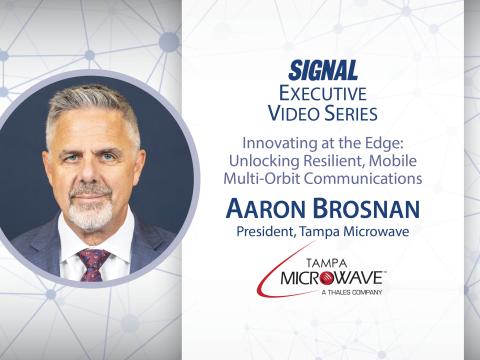Deployable Communications Network Outfits Military, Disaster Relief Missions
Global service can be customized to offer mobile office capabilities and connect decision makers to on-site incident response teams.
In less time than it takes rescue teams to save victims from life-threatening disasters, commercial engineers can deploy a communications network to fulfill operational needs in a crisis. The networks allow disaster relief organizations, commercial entities or the military to establish a communications chain in remote or devastated areas around the world and link decision makers to emergency response crews or operations commanders to field units. One telephone call to an operations center alerts a team of industry technicians who are immediately on their way to an incident site and can establish a communications network within an hour of their arrival.
The service supports voice, telephone, facsimile, digital imagery, data, video, remote local area network access and multimedia services. High-bandwidth earth stations provide global connectivity using microwave radios and satellites to connect remote incident sites to a hub.
The military has long sought fast, reliable communications to confront threats on the battlefield. While the need for a communications network sounds like a simple request, developing that network in the field—often with no lead time and on a temporary basis—can be a complex and costly procedure. Yet industry has advanced commercial alternatives that could enhance battlefield communications and disaster relief missions.
One company that is supporting the military and emergency response community’s communications needs is AT&T. Developers at the company’s laboratories in Middletown, New Jersey, have created a service that can be customized to help organizations deal with almost any incident where communications capabilities are required.
Company officials say that this effort to support voice, data and multimedia networks emerged from Cold War programs supporting the U.S. Department of Defense in air-to-ground communications. The technology has been used in demonstrations and exercises such as the Joint Warrior Interoperability Demonstration (JWID) 96, HUNTER WARRIOR AND BRIGHT STAR. Today, while the defense community is still a major potential user of the service, many other government and commercial customers have expressed interest in the service as well.
Telecommunications capabilities have increased dramatically since the time when operations centers only required deployable voice service. Now, in tactical situations the military and other nongovernmental organizations are asking telecommunications companies to become voice, data and multimedia service providers in environments where communications is key and the speed at which those communications capabilities can be deployed is crucial. Deployable communications to deal with emergency situations is on the doorstep and is ready for use, industry developers say.
In particular, the aviation industry has been looking at the service’s capabilities. This industry must be able to respond to any crisis immediately both inside and outside of the United States, and it recognizes the need for deployable communications systems to do this. The transportation industry, which needs rapid crisis management capabilities, requires these systems as well. Private insurance companies also could use the technology when doing claims analysis in a disaster situation. Additional users could include the National Guard, the State Department and special government agencies. The Federal Emergency Management Agency used this technology to aid in disaster recovery operations during floods in North Dakota in the spring of 1997.
The AT&T service supported the military during Desert Storm and also has worked with foreign entities in Bosnia and Herzegovina and Haiti. Networks have been created for both short- and long-term missions, depending on the individual response requirements. Typically, large organizations have used the service, but AT&T is considering allowing several small businesses to form a consortium to use the capability.
The service is “a full enterprise network that you can deploy,” Gerald A. Beierschmitt says. He is program manager for deployable communications at AT&T Government Markets. “The multiplicity of services that you would normally only have back home can now be taken with you,” he maintains. Beierschmitt submits that AT&T’s global extended network service provides a total office environment wherever it is needed.
In responding to an incident, agencies can use the service by contacting AT&T’s operations center. Technicians there determine what equipment is needed to provide the global extended network service. This equipment comes in rugged, transportable cases to withstand harsh environments. Next, the technicians arrive at the incident site to begin setting up a temporary communications center. The center could be housed in a nearby building or even in a tent, depending on the scenario.
Technicians are available on site around the clock during the mission and rely on additional support from U.S.-based technicians if needed. The communications network consists of both asynchronous transfer mode (ATM) and Internet protocol technology and can support up to 200 simultaneous voice calls in a single-shelf private branch exchange. Additional users can be added with more equipment.
Voice, integrated services digital network (ISDN) switched data and ISDN desktop videoconferencing services remain at the hub and are provided through the private branch exchange. The private branch exchange is connected with T-1 trunk cards to the ATM switch to facilitate wide area network calls. These trunks can end on the AT&T network switch or on the customer’s network.
An ATM switch provides voice compression and silence suppression and can link circuit switched voice, data and multimedia communications with Internet protocol functions. An Ethernet switch or router allows Internet protocol service by connecting to AT&T’s Internet protocol service network or to a private network. A subnet address assigned to the hub location allows routing to provide Internet protocol service between the hub and remote sites.
Also at the hub, a satellite communications terminal is used to transmit and receive signals. The terminal supports up to two T-1 lines and can operate in either the C band or Ku band. A line-of-sight radio system contains analog ports and an Ethernet port that link traffic between the hub and remote sites. A videoconferencing gateway connects up to eight users from one site to users at another site.
Customer-provided or AT&T terminals are linked to the standards-based AT&T architecture, which has analog, ISDN and Ethernet interfaces. The customer typically employs analog telephones, ISDN telephones, videoconferencing equipment and laptop computers at the hub location.
The ATM switch at the hub site allows service integration and offers efficient use of satellite bandwidth. A customer can determine how bandwidth will be used and can set priorities for voice and data traffic. The satellite bandwidth can be allocated based on traffic type, trunk group or physical local area network subnet. Priority can also be established for individual users as well.
The remote site also contains a line-of-sight radio system, an Ethernet switch or router, telephones, a videoconferencing terminal and computer terminals. The remote site can support wireless transmissions, including cellular, land-mobile radio or unlicensed systems that can support voice over Internet protocol. Having deployable wireless communications is an attractive feature for both military and disaster relief teams who often rely on mobile communications capabilities in tactical scenarios.
The service also includes use of AT&T’s fixed network that contains satellite teleports to provide worldwide connectivity. The service hub contains a channel service unit and a network management terminal. An ATM switch serves as an end point as well as a network management hub. Network status can be monitored to provide consistent system management.
“There’s a lot of on-the-fly engineering involved,” Robert S. Bateman, technology consultant for AT&T Laboratories explains. “A lot of ingenuity takes place on site, ” he adds about the network design involved in establishing the service. Because there is no site survey, technicians must make quick decisions to build a network from the ground up.
Users can have secure voice and data capabilities as well. The service offers several standard voice and data encryption options, including bulk encryption and ATM cell encryption. It can use the United States’ data encryption standard and other government-approved algorithms to provide information security. The technicians who maintain the on-site location have clearances to work in a sensitive environment as well. “The classified environment is no problem,” Bateman says.



Comments